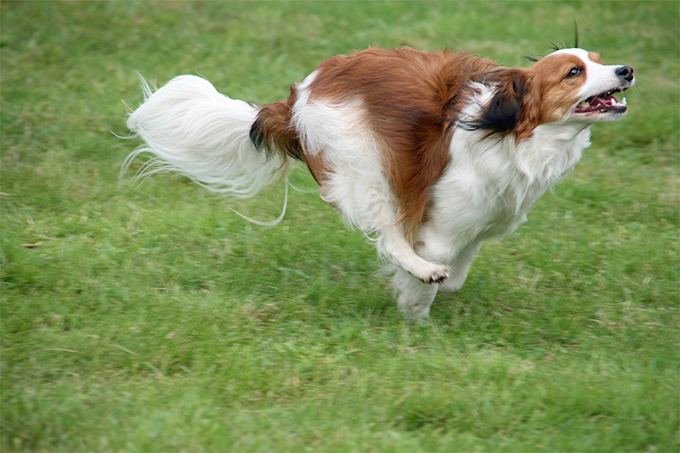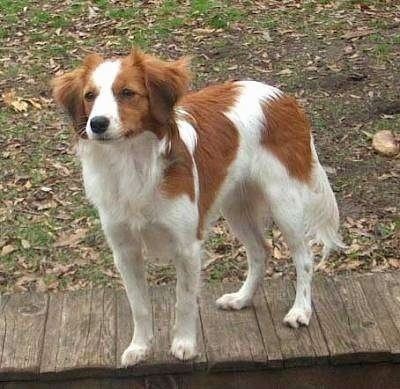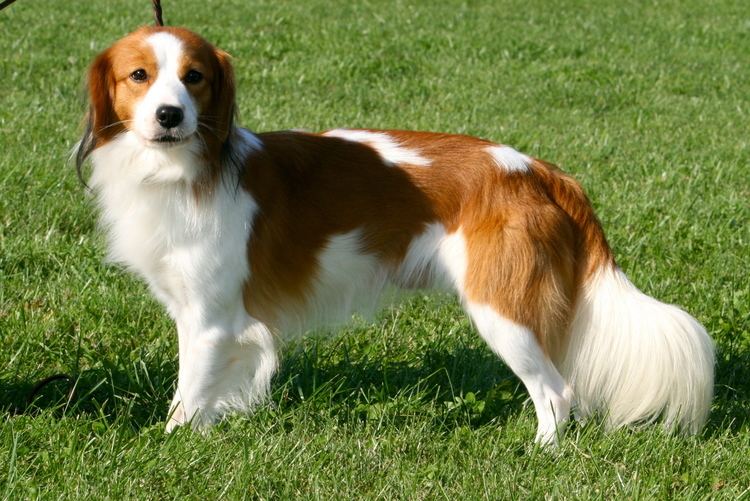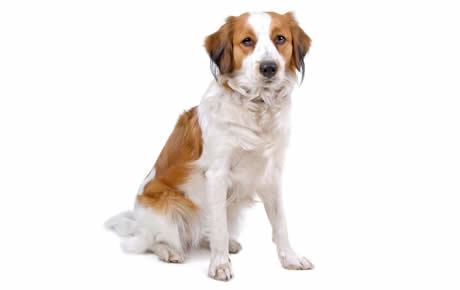Common nicknames Kooiker Miscellaneous standard Gundog standard Life span 12 – 14 years | AKC Miscellaneous Hypoallergenic No Mass 9 – 11 kg | |
 | ||
FCI Group 8, Section 2 Flushing Dogs #314 Height 35 – 40 cm (At the withers) Temperament Benevolent, Alert, Agile, Active, Intelligent, Territorial Similar Stabyhoun, Kromfohrländer, Nova Scotia Duck Tolli, Wetterhoun, Small Münsterländer | ||
Kooikerhondje dog breed
The Kooikerhondje (literal English translation "little cager dog" or "little caging dog") is a small spaniel-type breed of dog of Dutch ancestry that was originally used as a working dog, particularly in an eendenkooi (duck cage) to lure ducks. Kooikers were popular in the 17th and 18th century and appeared in the paintings of Rembrandt and Jan Steen. The breed is rapidly gaining popularity in the United States, Canada and Scandinavia, where it is still relatively unknown.
Contents
- Kooikerhondje dog breed
- Bobtail kooikerhondje breed 16 1 2013
- Appearance
- Temperament
- Health
- History
- References

Bobtail kooikerhondje breed 16 1 2013
Appearance

The Kooikerhondje is a small, flashy, orange and white spaniel-like sporting dog. Originally bred in Holland as a duck decoy dog, its heavily white plumed tail waves jauntily to entice and lure ducks to follow it into Eendenkooi (duck cages). When not working the traps, Kooikers were expected to work on the farm to catch vermin. The preferred height at the withers is 15 to 17 inches for males and 14 to 16 inches for females. The proportion of the Kooiker is off-square. The bone and substance of the Kooiker is moderate. The head should be in proportion to the dog. The expression is gentle and alert. Ears should be red in color and well feathered and ideally adorned with earrings. The color for the Kooiker should be predominately orange-red and may be patched or solid on pure white although a few small spots on the legs are acceptable. A black tail ring where the color changes from orange-red to white is permitted.
Temperament

Cheerful, good natured, friendly, quiet, well-behaved, and alert; those are terms that are used to describe the Kooikerhondje. Depending on its domestic environment, it is kind, happy and lively. They are also intelligent, attentive and more than willing to please their owner. The Kooikerhondje adapts to situations rather quickly, changing his behavior from quiet to lively when the situation allows him to be. He will not always immediately like strangers, instead choosing to retreat. But once he warms up to someone, the trust will be there for the rest of his life. The Kooikerhondje can make a fine apartment dog if exercised regularly, but a fenced yard will be more ideal. He has a medium energy level, yet is usually quiet when indoors. Kooikerhondje can be reactive with strange dogs and are wary of boisterous children, in general.
Health

Kooikers have good appetites and a tendency to put on weight easily. Their life span is 12–14 years. As Kooikerhondjes have a small genetic base, hereditary diseases were somewhat prevalent earlier. These include:
Today (due to a lot of hard work in the national clubs) most Kooikers used for breeding are free from von Willebrands disease (most national clubs require both male and female dogs to be free from this disease to be allowed to breed). Patellar luxation is not a major problem in most countries at the moment, but is kept under a close watch to prevent it from becoming a problem again. In the Netherlands, eye tests are available and all breeders breeding according to the breed club's rules have to test their dogs. Only dogs that are free of eye diseases are allowed to be used for breeding. Testing for ENM became available in 2012. In the Netherlands, only dogs who are tested may be used for breeding. Only allowed breedings are Free x Free or Free X Carrier. Carrier to Carrier should never be done as the risk of this fatal disease is high. Puppy purchasers should inquire about the ENM status of the parents.
History
The Kooikerhondje was developed in the Netherlands around the sixteenth century to be a tolling breed. They were used to lure and drive ducks into 'kooien' (cages in the form of canals with traps at the ends), where the hunter (the so-called Kooiker) could easily catch the fowl. The dogs that were used by the Kooiker for this kind of hunting technique, were referred to as the 'Kooiker's hondjes' (literally: Kooiker's dogs). Eventually this led to this dog being called Kooikerhondje.
The breed almost became extinct after World War II until Baroness van Hardenbroek van Ammerstol rescued it. The breed was only officially recognized by the Raad van Beheer, the Dutch Kennel Club, in 1971 and has since been imported into other countries and recognised officially. The breed is still relatively unknown in North America and not yet recognized as a breed in Canada, although it has been accepted into the AKC's FSS program, was moved to the AKC Miscellaneous class on July 1, 2015 in preparation to moving to the Sporting Group upon full recognition. In the United States, both the UKC and ARBA recognize the breed.
In the UK, the breed has been removed from the import list and is now eligible to enter Crufts for the Best in Show award, despite there being only 76 of the breed in the UK.
In January 2013, the Kennel Club announced it was re-classifying the Kooikerhondje from the gundog group to the utility group effective from January 2014. The decision was reached after discussions with the UK breed clubs and unanimous agreement was achieved.
Some historians believe the Kooikerhondje may have possibly played a part in the development of the Nova Scotia Duck-Tolling Retriever.
